A Report on Absenteeism in the Workplace: IRHR2010, 1st Semester
VerifiedAdded on 2022/08/24
|12
|2604
|19
Report
AI Summary
This report addresses the issue of absenteeism in the workplace, focusing on its causes, consequences, and potential solutions. The report begins with an executive summary and table of contents, followed by an introduction that defines absenteeism and explores various contributing factors. The discussion section analyzes individual, workplace, and societal determinants of absenteeism, including illness, family responsibilities, and organizational culture. The report examines the case scenario of Henry Worth, CEO of NU-mart, and provides recommendations to address the rising absenteeism rate, such as implementing attendance policies and rewarding good attendance. The report concludes by summarizing the key findings and reiterating the importance of understanding and managing absenteeism to improve employee engagement and organizational productivity. References are included to support the analysis and recommendations.
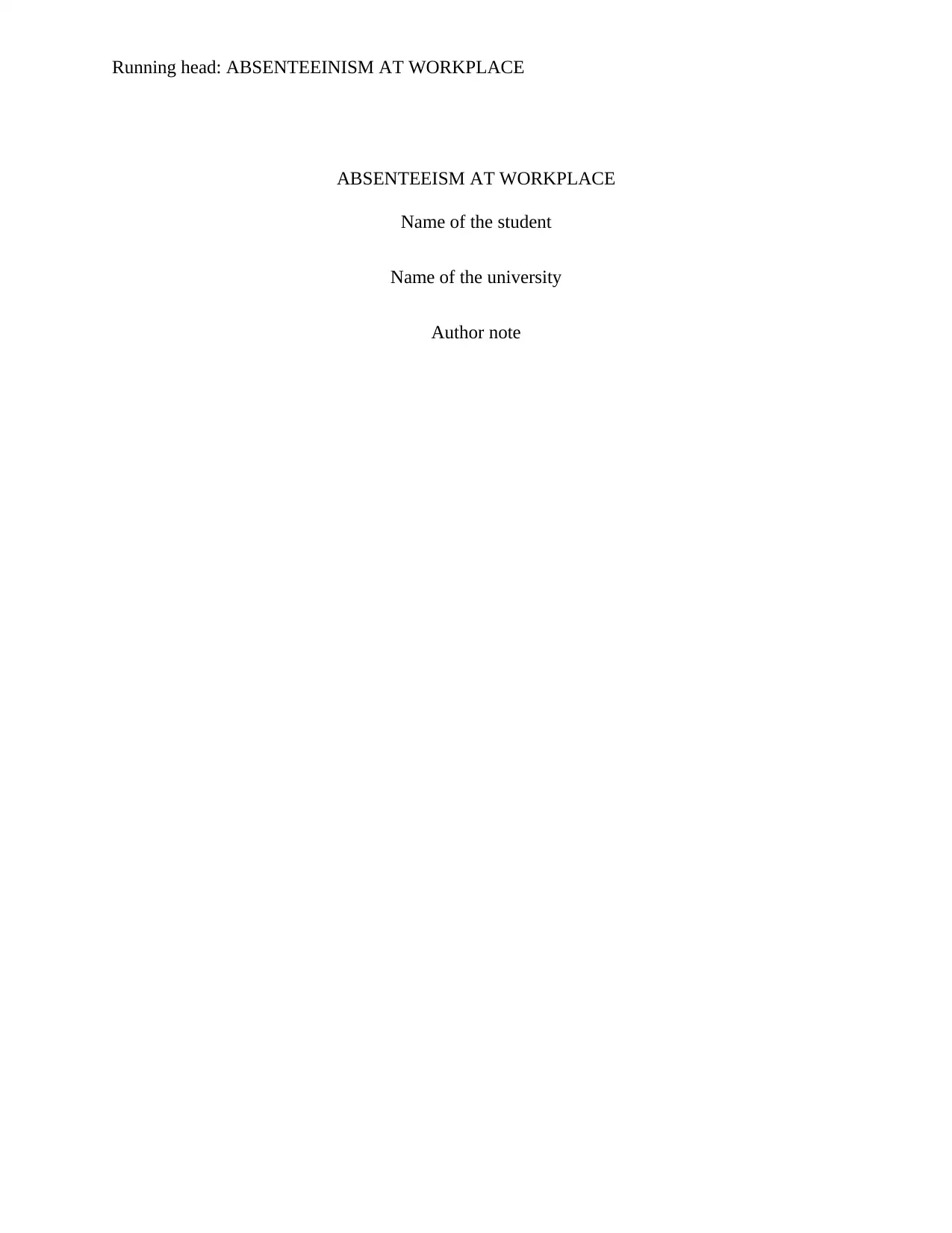
Running head: ABSENTEEINISM AT WORKPLACE
ABSENTEEISM AT WORKPLACE
Name of the student
Name of the university
Author note
ABSENTEEISM AT WORKPLACE
Name of the student
Name of the university
Author note
Paraphrase This Document
Need a fresh take? Get an instant paraphrase of this document with our AI Paraphraser
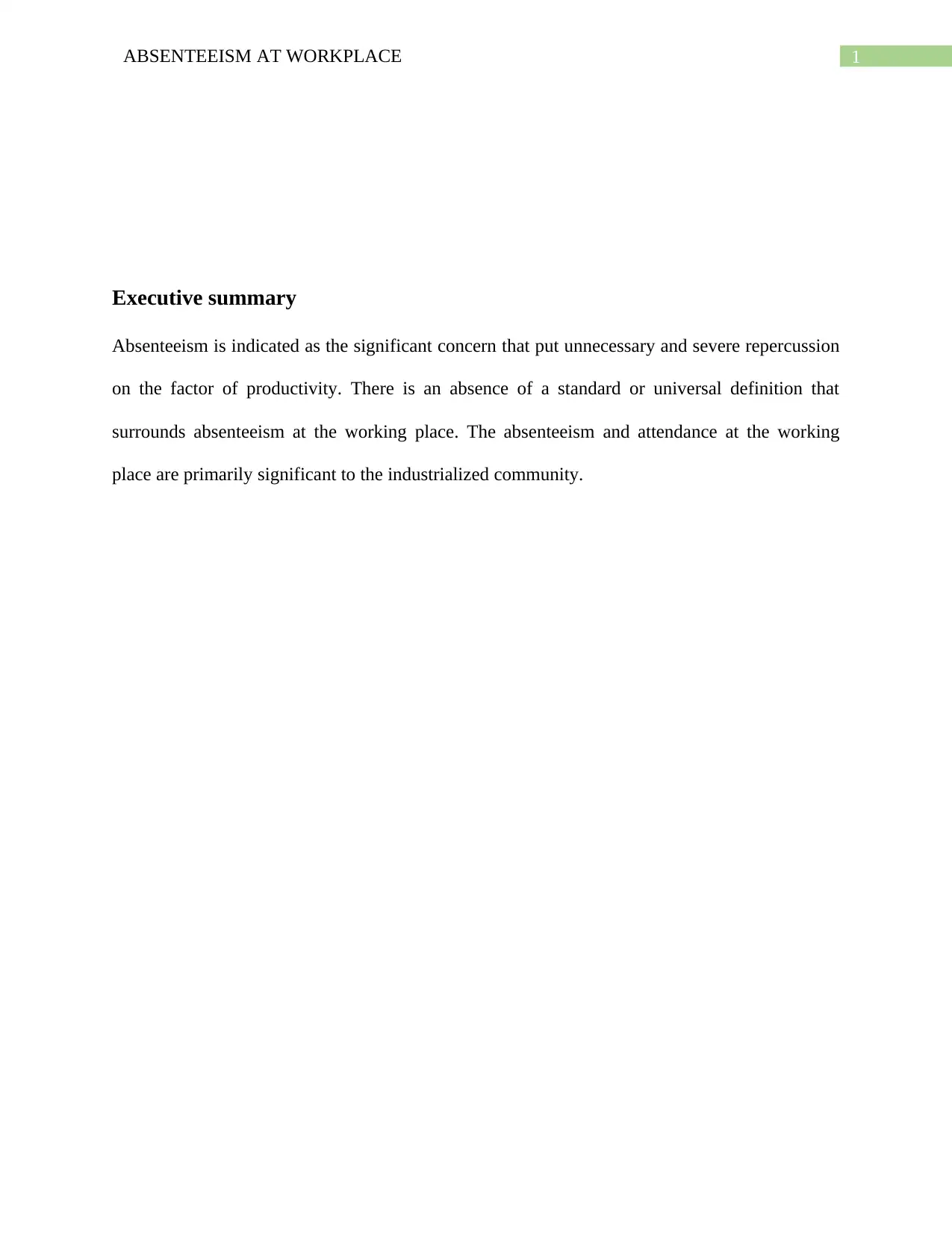
1ABSENTEEISM AT WORKPLACE
Executive summary
Absenteeism is indicated as the significant concern that put unnecessary and severe repercussion
on the factor of productivity. There is an absence of a standard or universal definition that
surrounds absenteeism at the working place. The absenteeism and attendance at the working
place are primarily significant to the industrialized community.
Executive summary
Absenteeism is indicated as the significant concern that put unnecessary and severe repercussion
on the factor of productivity. There is an absence of a standard or universal definition that
surrounds absenteeism at the working place. The absenteeism and attendance at the working
place are primarily significant to the industrialized community.
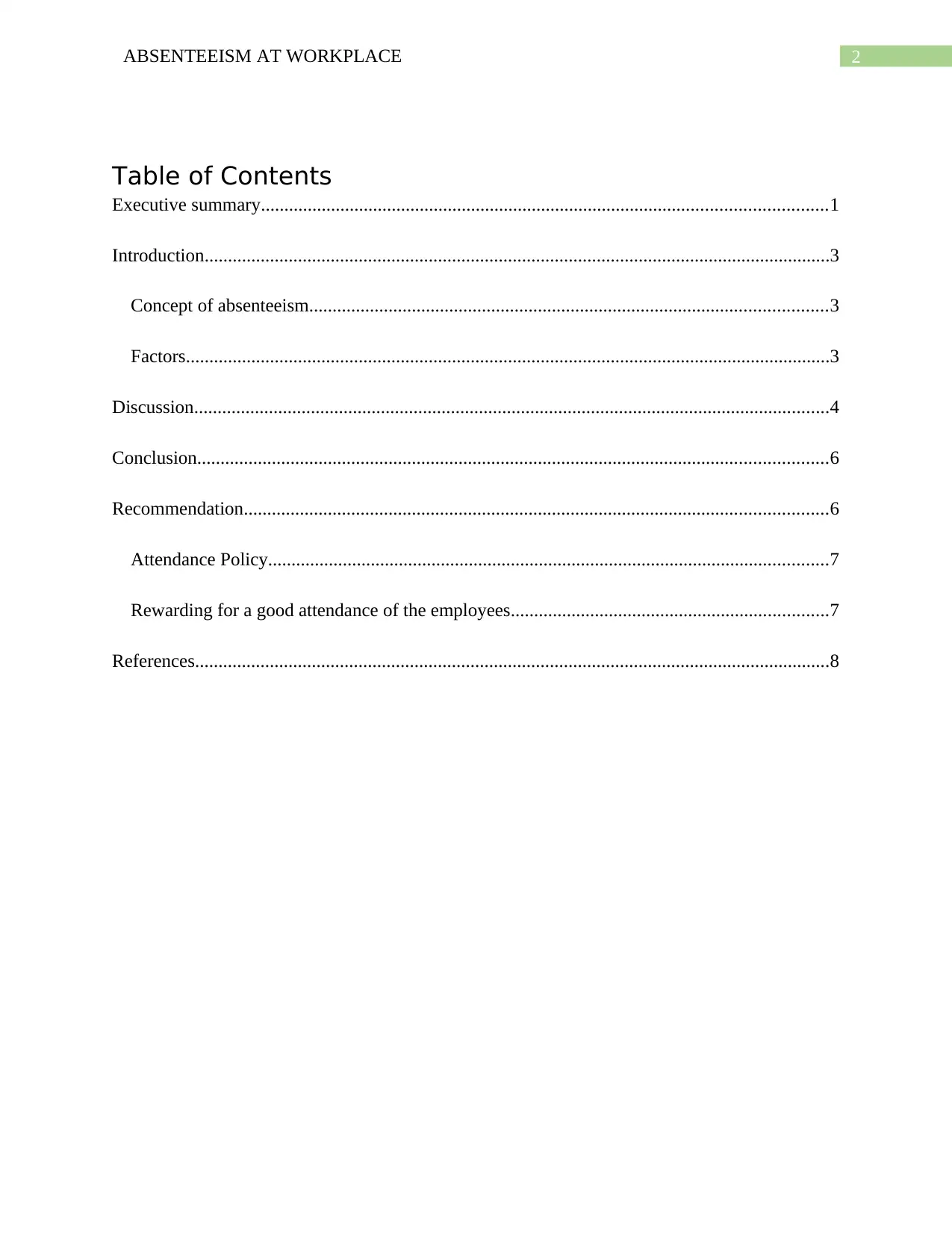
2ABSENTEEISM AT WORKPLACE
Table of Contents
Executive summary.........................................................................................................................1
Introduction......................................................................................................................................3
Concept of absenteeism...............................................................................................................3
Factors..........................................................................................................................................3
Discussion........................................................................................................................................4
Conclusion.......................................................................................................................................6
Recommendation.............................................................................................................................6
Attendance Policy........................................................................................................................7
Rewarding for a good attendance of the employees....................................................................7
References........................................................................................................................................8
Table of Contents
Executive summary.........................................................................................................................1
Introduction......................................................................................................................................3
Concept of absenteeism...............................................................................................................3
Factors..........................................................................................................................................3
Discussion........................................................................................................................................4
Conclusion.......................................................................................................................................6
Recommendation.............................................................................................................................6
Attendance Policy........................................................................................................................7
Rewarding for a good attendance of the employees....................................................................7
References........................................................................................................................................8
⊘ This is a preview!⊘
Do you want full access?
Subscribe today to unlock all pages.

Trusted by 1+ million students worldwide
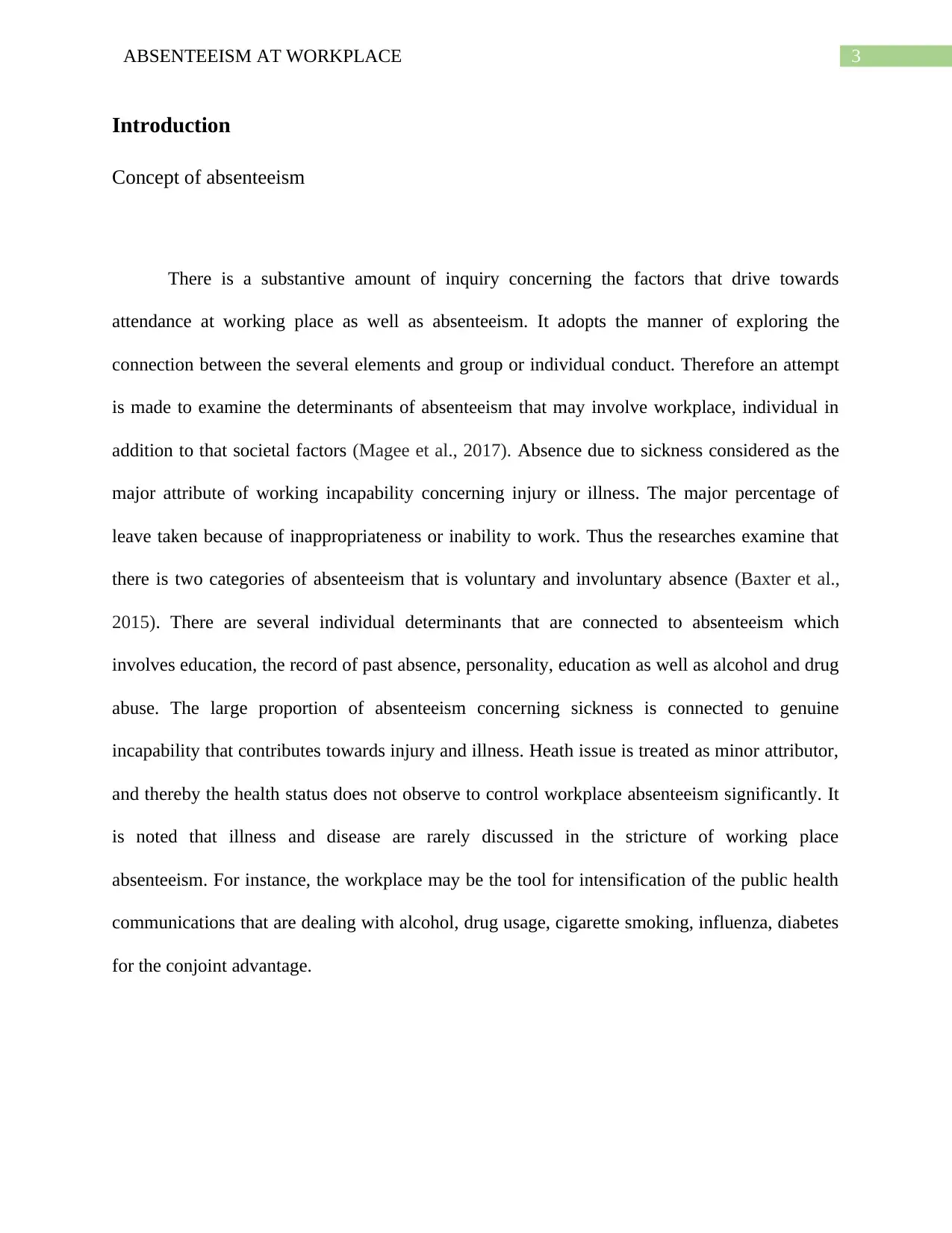
3ABSENTEEISM AT WORKPLACE
Introduction
Concept of absenteeism
There is a substantive amount of inquiry concerning the factors that drive towards
attendance at working place as well as absenteeism. It adopts the manner of exploring the
connection between the several elements and group or individual conduct. Therefore an attempt
is made to examine the determinants of absenteeism that may involve workplace, individual in
addition to that societal factors (Magee et al., 2017). Absence due to sickness considered as the
major attribute of working incapability concerning injury or illness. The major percentage of
leave taken because of inappropriateness or inability to work. Thus the researches examine that
there is two categories of absenteeism that is voluntary and involuntary absence (Baxter et al.,
2015). There are several individual determinants that are connected to absenteeism which
involves education, the record of past absence, personality, education as well as alcohol and drug
abuse. The large proportion of absenteeism concerning sickness is connected to genuine
incapability that contributes towards injury and illness. Heath issue is treated as minor attributor,
and thereby the health status does not observe to control workplace absenteeism significantly. It
is noted that illness and disease are rarely discussed in the stricture of working place
absenteeism. For instance, the workplace may be the tool for intensification of the public health
communications that are dealing with alcohol, drug usage, cigarette smoking, influenza, diabetes
for the conjoint advantage.
Introduction
Concept of absenteeism
There is a substantive amount of inquiry concerning the factors that drive towards
attendance at working place as well as absenteeism. It adopts the manner of exploring the
connection between the several elements and group or individual conduct. Therefore an attempt
is made to examine the determinants of absenteeism that may involve workplace, individual in
addition to that societal factors (Magee et al., 2017). Absence due to sickness considered as the
major attribute of working incapability concerning injury or illness. The major percentage of
leave taken because of inappropriateness or inability to work. Thus the researches examine that
there is two categories of absenteeism that is voluntary and involuntary absence (Baxter et al.,
2015). There are several individual determinants that are connected to absenteeism which
involves education, the record of past absence, personality, education as well as alcohol and drug
abuse. The large proportion of absenteeism concerning sickness is connected to genuine
incapability that contributes towards injury and illness. Heath issue is treated as minor attributor,
and thereby the health status does not observe to control workplace absenteeism significantly. It
is noted that illness and disease are rarely discussed in the stricture of working place
absenteeism. For instance, the workplace may be the tool for intensification of the public health
communications that are dealing with alcohol, drug usage, cigarette smoking, influenza, diabetes
for the conjoint advantage.
Paraphrase This Document
Need a fresh take? Get an instant paraphrase of this document with our AI Paraphraser
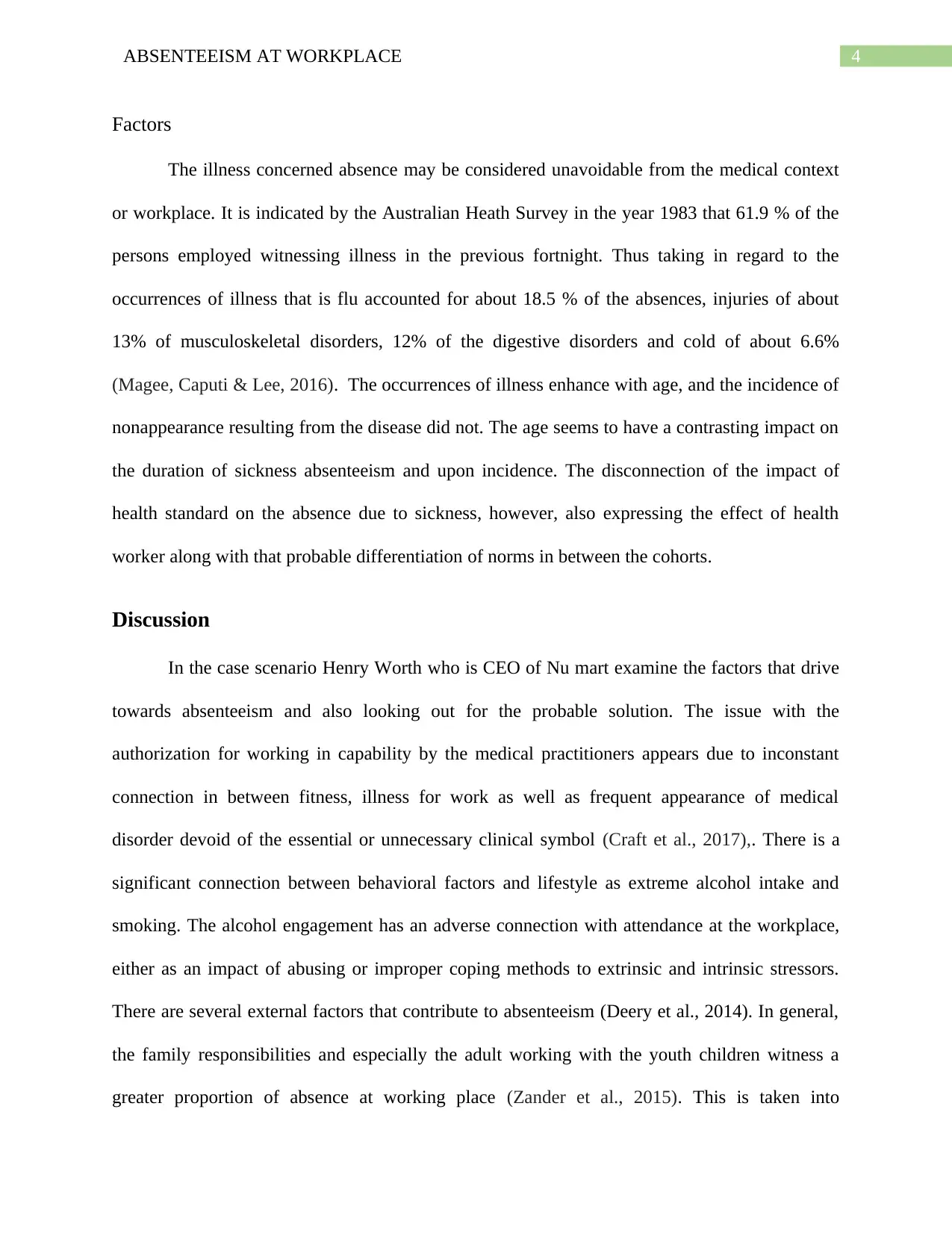
4ABSENTEEISM AT WORKPLACE
Factors
The illness concerned absence may be considered unavoidable from the medical context
or workplace. It is indicated by the Australian Heath Survey in the year 1983 that 61.9 % of the
persons employed witnessing illness in the previous fortnight. Thus taking in regard to the
occurrences of illness that is flu accounted for about 18.5 % of the absences, injuries of about
13% of musculoskeletal disorders, 12% of the digestive disorders and cold of about 6.6%
(Magee, Caputi & Lee, 2016). The occurrences of illness enhance with age, and the incidence of
nonappearance resulting from the disease did not. The age seems to have a contrasting impact on
the duration of sickness absenteeism and upon incidence. The disconnection of the impact of
health standard on the absence due to sickness, however, also expressing the effect of health
worker along with that probable differentiation of norms in between the cohorts.
Discussion
In the case scenario Henry Worth who is CEO of Nu mart examine the factors that drive
towards absenteeism and also looking out for the probable solution. The issue with the
authorization for working in capability by the medical practitioners appears due to inconstant
connection in between fitness, illness for work as well as frequent appearance of medical
disorder devoid of the essential or unnecessary clinical symbol (Craft et al., 2017),. There is a
significant connection between behavioral factors and lifestyle as extreme alcohol intake and
smoking. The alcohol engagement has an adverse connection with attendance at the workplace,
either as an impact of abusing or improper coping methods to extrinsic and intrinsic stressors.
There are several external factors that contribute to absenteeism (Deery et al., 2014). In general,
the family responsibilities and especially the adult working with the youth children witness a
greater proportion of absence at working place (Zander et al., 2015). This is taken into
Factors
The illness concerned absence may be considered unavoidable from the medical context
or workplace. It is indicated by the Australian Heath Survey in the year 1983 that 61.9 % of the
persons employed witnessing illness in the previous fortnight. Thus taking in regard to the
occurrences of illness that is flu accounted for about 18.5 % of the absences, injuries of about
13% of musculoskeletal disorders, 12% of the digestive disorders and cold of about 6.6%
(Magee, Caputi & Lee, 2016). The occurrences of illness enhance with age, and the incidence of
nonappearance resulting from the disease did not. The age seems to have a contrasting impact on
the duration of sickness absenteeism and upon incidence. The disconnection of the impact of
health standard on the absence due to sickness, however, also expressing the effect of health
worker along with that probable differentiation of norms in between the cohorts.
Discussion
In the case scenario Henry Worth who is CEO of Nu mart examine the factors that drive
towards absenteeism and also looking out for the probable solution. The issue with the
authorization for working in capability by the medical practitioners appears due to inconstant
connection in between fitness, illness for work as well as frequent appearance of medical
disorder devoid of the essential or unnecessary clinical symbol (Craft et al., 2017),. There is a
significant connection between behavioral factors and lifestyle as extreme alcohol intake and
smoking. The alcohol engagement has an adverse connection with attendance at the workplace,
either as an impact of abusing or improper coping methods to extrinsic and intrinsic stressors.
There are several external factors that contribute to absenteeism (Deery et al., 2014). In general,
the family responsibilities and especially the adult working with the youth children witness a
greater proportion of absence at working place (Zander et al., 2015). This is taken into
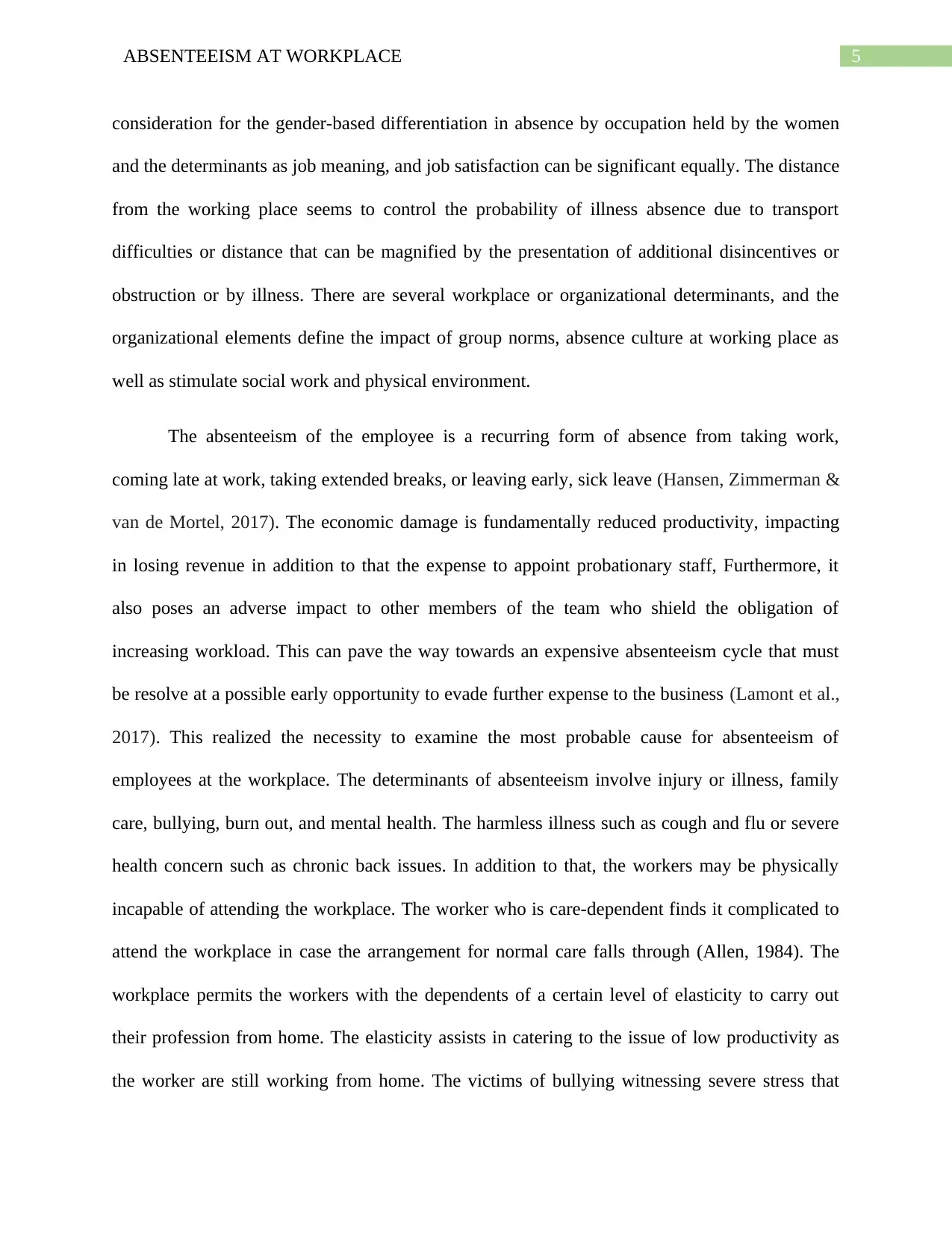
5ABSENTEEISM AT WORKPLACE
consideration for the gender-based differentiation in absence by occupation held by the women
and the determinants as job meaning, and job satisfaction can be significant equally. The distance
from the working place seems to control the probability of illness absence due to transport
difficulties or distance that can be magnified by the presentation of additional disincentives or
obstruction or by illness. There are several workplace or organizational determinants, and the
organizational elements define the impact of group norms, absence culture at working place as
well as stimulate social work and physical environment.
The absenteeism of the employee is a recurring form of absence from taking work,
coming late at work, taking extended breaks, or leaving early, sick leave (Hansen, Zimmerman &
van de Mortel, 2017). The economic damage is fundamentally reduced productivity, impacting
in losing revenue in addition to that the expense to appoint probationary staff, Furthermore, it
also poses an adverse impact to other members of the team who shield the obligation of
increasing workload. This can pave the way towards an expensive absenteeism cycle that must
be resolve at a possible early opportunity to evade further expense to the business (Lamont et al.,
2017). This realized the necessity to examine the most probable cause for absenteeism of
employees at the workplace. The determinants of absenteeism involve injury or illness, family
care, bullying, burn out, and mental health. The harmless illness such as cough and flu or severe
health concern such as chronic back issues. In addition to that, the workers may be physically
incapable of attending the workplace. The worker who is care-dependent finds it complicated to
attend the workplace in case the arrangement for normal care falls through (Allen, 1984). The
workplace permits the workers with the dependents of a certain level of elasticity to carry out
their profession from home. The elasticity assists in catering to the issue of low productivity as
the worker are still working from home. The victims of bullying witnessing severe stress that
consideration for the gender-based differentiation in absence by occupation held by the women
and the determinants as job meaning, and job satisfaction can be significant equally. The distance
from the working place seems to control the probability of illness absence due to transport
difficulties or distance that can be magnified by the presentation of additional disincentives or
obstruction or by illness. There are several workplace or organizational determinants, and the
organizational elements define the impact of group norms, absence culture at working place as
well as stimulate social work and physical environment.
The absenteeism of the employee is a recurring form of absence from taking work,
coming late at work, taking extended breaks, or leaving early, sick leave (Hansen, Zimmerman &
van de Mortel, 2017). The economic damage is fundamentally reduced productivity, impacting
in losing revenue in addition to that the expense to appoint probationary staff, Furthermore, it
also poses an adverse impact to other members of the team who shield the obligation of
increasing workload. This can pave the way towards an expensive absenteeism cycle that must
be resolve at a possible early opportunity to evade further expense to the business (Lamont et al.,
2017). This realized the necessity to examine the most probable cause for absenteeism of
employees at the workplace. The determinants of absenteeism involve injury or illness, family
care, bullying, burn out, and mental health. The harmless illness such as cough and flu or severe
health concern such as chronic back issues. In addition to that, the workers may be physically
incapable of attending the workplace. The worker who is care-dependent finds it complicated to
attend the workplace in case the arrangement for normal care falls through (Allen, 1984). The
workplace permits the workers with the dependents of a certain level of elasticity to carry out
their profession from home. The elasticity assists in catering to the issue of low productivity as
the worker are still working from home. The victims of bullying witnessing severe stress that
⊘ This is a preview!⊘
Do you want full access?
Subscribe today to unlock all pages.

Trusted by 1+ million students worldwide
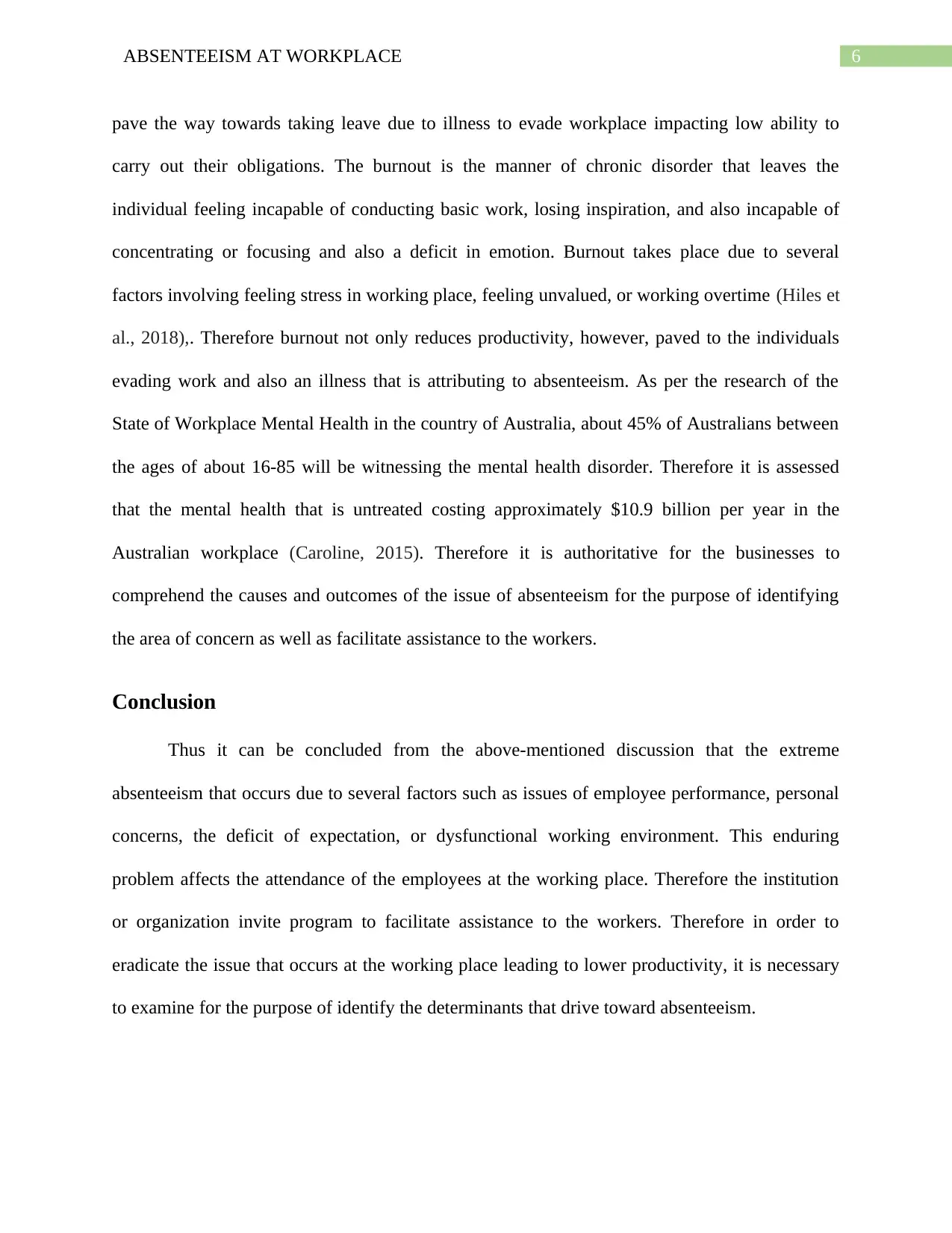
6ABSENTEEISM AT WORKPLACE
pave the way towards taking leave due to illness to evade workplace impacting low ability to
carry out their obligations. The burnout is the manner of chronic disorder that leaves the
individual feeling incapable of conducting basic work, losing inspiration, and also incapable of
concentrating or focusing and also a deficit in emotion. Burnout takes place due to several
factors involving feeling stress in working place, feeling unvalued, or working overtime (Hiles et
al., 2018),. Therefore burnout not only reduces productivity, however, paved to the individuals
evading work and also an illness that is attributing to absenteeism. As per the research of the
State of Workplace Mental Health in the country of Australia, about 45% of Australians between
the ages of about 16-85 will be witnessing the mental health disorder. Therefore it is assessed
that the mental health that is untreated costing approximately $10.9 billion per year in the
Australian workplace (Caroline, 2015). Therefore it is authoritative for the businesses to
comprehend the causes and outcomes of the issue of absenteeism for the purpose of identifying
the area of concern as well as facilitate assistance to the workers.
Conclusion
Thus it can be concluded from the above-mentioned discussion that the extreme
absenteeism that occurs due to several factors such as issues of employee performance, personal
concerns, the deficit of expectation, or dysfunctional working environment. This enduring
problem affects the attendance of the employees at the working place. Therefore the institution
or organization invite program to facilitate assistance to the workers. Therefore in order to
eradicate the issue that occurs at the working place leading to lower productivity, it is necessary
to examine for the purpose of identify the determinants that drive toward absenteeism.
pave the way towards taking leave due to illness to evade workplace impacting low ability to
carry out their obligations. The burnout is the manner of chronic disorder that leaves the
individual feeling incapable of conducting basic work, losing inspiration, and also incapable of
concentrating or focusing and also a deficit in emotion. Burnout takes place due to several
factors involving feeling stress in working place, feeling unvalued, or working overtime (Hiles et
al., 2018),. Therefore burnout not only reduces productivity, however, paved to the individuals
evading work and also an illness that is attributing to absenteeism. As per the research of the
State of Workplace Mental Health in the country of Australia, about 45% of Australians between
the ages of about 16-85 will be witnessing the mental health disorder. Therefore it is assessed
that the mental health that is untreated costing approximately $10.9 billion per year in the
Australian workplace (Caroline, 2015). Therefore it is authoritative for the businesses to
comprehend the causes and outcomes of the issue of absenteeism for the purpose of identifying
the area of concern as well as facilitate assistance to the workers.
Conclusion
Thus it can be concluded from the above-mentioned discussion that the extreme
absenteeism that occurs due to several factors such as issues of employee performance, personal
concerns, the deficit of expectation, or dysfunctional working environment. This enduring
problem affects the attendance of the employees at the working place. Therefore the institution
or organization invite program to facilitate assistance to the workers. Therefore in order to
eradicate the issue that occurs at the working place leading to lower productivity, it is necessary
to examine for the purpose of identify the determinants that drive toward absenteeism.
Paraphrase This Document
Need a fresh take? Get an instant paraphrase of this document with our AI Paraphraser
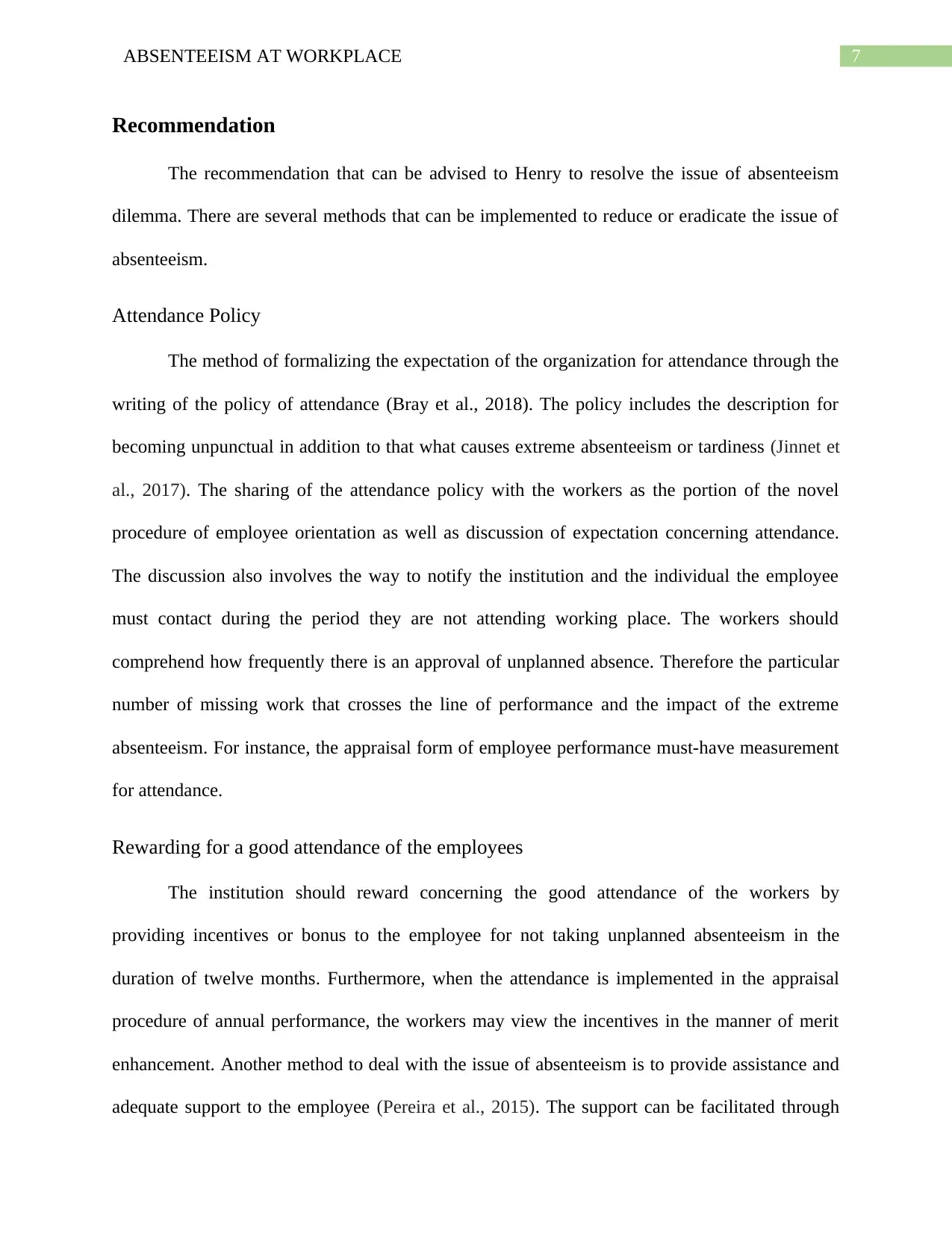
7ABSENTEEISM AT WORKPLACE
Recommendation
The recommendation that can be advised to Henry to resolve the issue of absenteeism
dilemma. There are several methods that can be implemented to reduce or eradicate the issue of
absenteeism.
Attendance Policy
The method of formalizing the expectation of the organization for attendance through the
writing of the policy of attendance (Bray et al., 2018). The policy includes the description for
becoming unpunctual in addition to that what causes extreme absenteeism or tardiness (Jinnet et
al., 2017). The sharing of the attendance policy with the workers as the portion of the novel
procedure of employee orientation as well as discussion of expectation concerning attendance.
The discussion also involves the way to notify the institution and the individual the employee
must contact during the period they are not attending working place. The workers should
comprehend how frequently there is an approval of unplanned absence. Therefore the particular
number of missing work that crosses the line of performance and the impact of the extreme
absenteeism. For instance, the appraisal form of employee performance must-have measurement
for attendance.
Rewarding for a good attendance of the employees
The institution should reward concerning the good attendance of the workers by
providing incentives or bonus to the employee for not taking unplanned absenteeism in the
duration of twelve months. Furthermore, when the attendance is implemented in the appraisal
procedure of annual performance, the workers may view the incentives in the manner of merit
enhancement. Another method to deal with the issue of absenteeism is to provide assistance and
adequate support to the employee (Pereira et al., 2015). The support can be facilitated through
Recommendation
The recommendation that can be advised to Henry to resolve the issue of absenteeism
dilemma. There are several methods that can be implemented to reduce or eradicate the issue of
absenteeism.
Attendance Policy
The method of formalizing the expectation of the organization for attendance through the
writing of the policy of attendance (Bray et al., 2018). The policy includes the description for
becoming unpunctual in addition to that what causes extreme absenteeism or tardiness (Jinnet et
al., 2017). The sharing of the attendance policy with the workers as the portion of the novel
procedure of employee orientation as well as discussion of expectation concerning attendance.
The discussion also involves the way to notify the institution and the individual the employee
must contact during the period they are not attending working place. The workers should
comprehend how frequently there is an approval of unplanned absence. Therefore the particular
number of missing work that crosses the line of performance and the impact of the extreme
absenteeism. For instance, the appraisal form of employee performance must-have measurement
for attendance.
Rewarding for a good attendance of the employees
The institution should reward concerning the good attendance of the workers by
providing incentives or bonus to the employee for not taking unplanned absenteeism in the
duration of twelve months. Furthermore, when the attendance is implemented in the appraisal
procedure of annual performance, the workers may view the incentives in the manner of merit
enhancement. Another method to deal with the issue of absenteeism is to provide assistance and
adequate support to the employee (Pereira et al., 2015). The support can be facilitated through
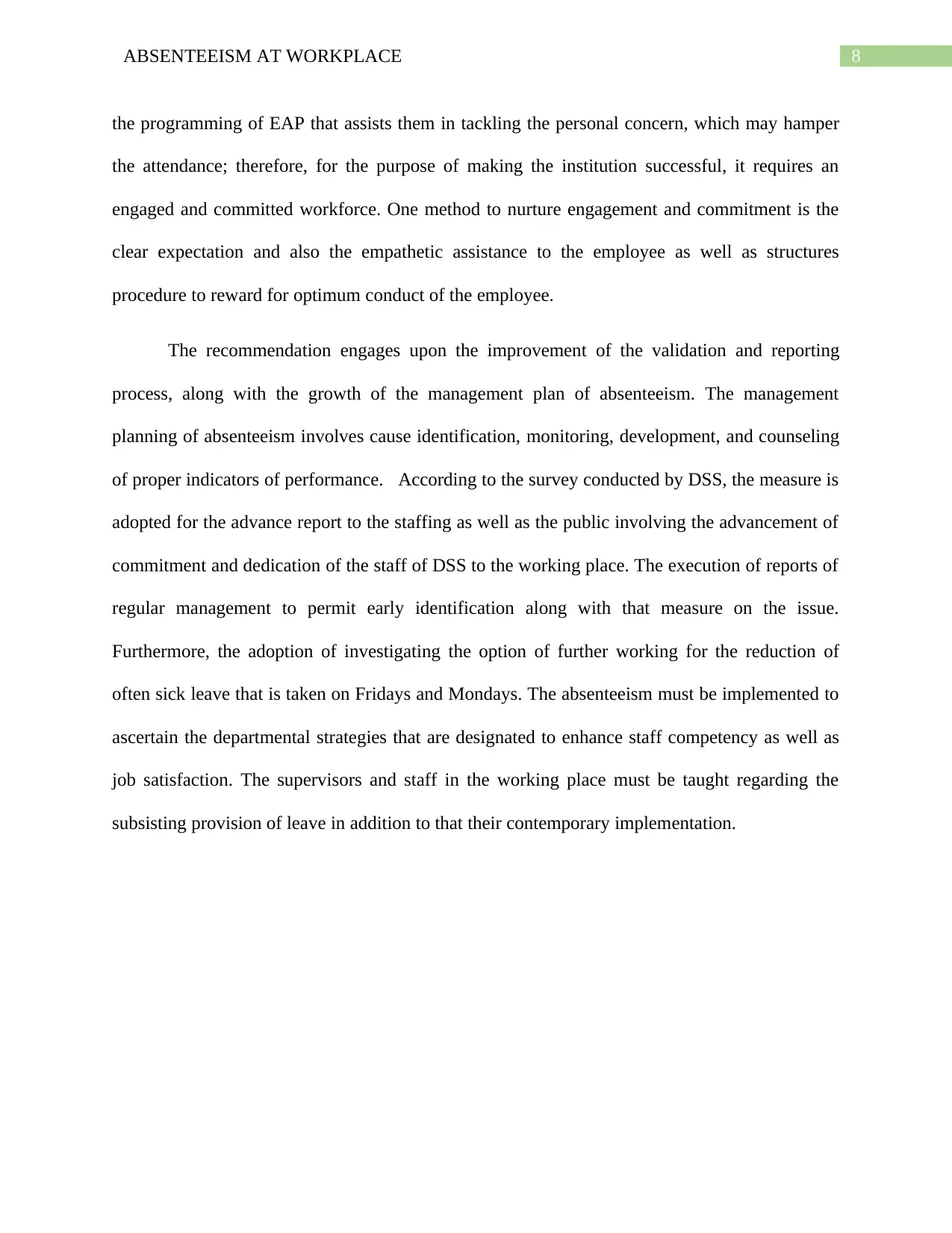
8ABSENTEEISM AT WORKPLACE
the programming of EAP that assists them in tackling the personal concern, which may hamper
the attendance; therefore, for the purpose of making the institution successful, it requires an
engaged and committed workforce. One method to nurture engagement and commitment is the
clear expectation and also the empathetic assistance to the employee as well as structures
procedure to reward for optimum conduct of the employee.
The recommendation engages upon the improvement of the validation and reporting
process, along with the growth of the management plan of absenteeism. The management
planning of absenteeism involves cause identification, monitoring, development, and counseling
of proper indicators of performance. According to the survey conducted by DSS, the measure is
adopted for the advance report to the staffing as well as the public involving the advancement of
commitment and dedication of the staff of DSS to the working place. The execution of reports of
regular management to permit early identification along with that measure on the issue.
Furthermore, the adoption of investigating the option of further working for the reduction of
often sick leave that is taken on Fridays and Mondays. The absenteeism must be implemented to
ascertain the departmental strategies that are designated to enhance staff competency as well as
job satisfaction. The supervisors and staff in the working place must be taught regarding the
subsisting provision of leave in addition to that their contemporary implementation.
the programming of EAP that assists them in tackling the personal concern, which may hamper
the attendance; therefore, for the purpose of making the institution successful, it requires an
engaged and committed workforce. One method to nurture engagement and commitment is the
clear expectation and also the empathetic assistance to the employee as well as structures
procedure to reward for optimum conduct of the employee.
The recommendation engages upon the improvement of the validation and reporting
process, along with the growth of the management plan of absenteeism. The management
planning of absenteeism involves cause identification, monitoring, development, and counseling
of proper indicators of performance. According to the survey conducted by DSS, the measure is
adopted for the advance report to the staffing as well as the public involving the advancement of
commitment and dedication of the staff of DSS to the working place. The execution of reports of
regular management to permit early identification along with that measure on the issue.
Furthermore, the adoption of investigating the option of further working for the reduction of
often sick leave that is taken on Fridays and Mondays. The absenteeism must be implemented to
ascertain the departmental strategies that are designated to enhance staff competency as well as
job satisfaction. The supervisors and staff in the working place must be taught regarding the
subsisting provision of leave in addition to that their contemporary implementation.
⊘ This is a preview!⊘
Do you want full access?
Subscribe today to unlock all pages.

Trusted by 1+ million students worldwide
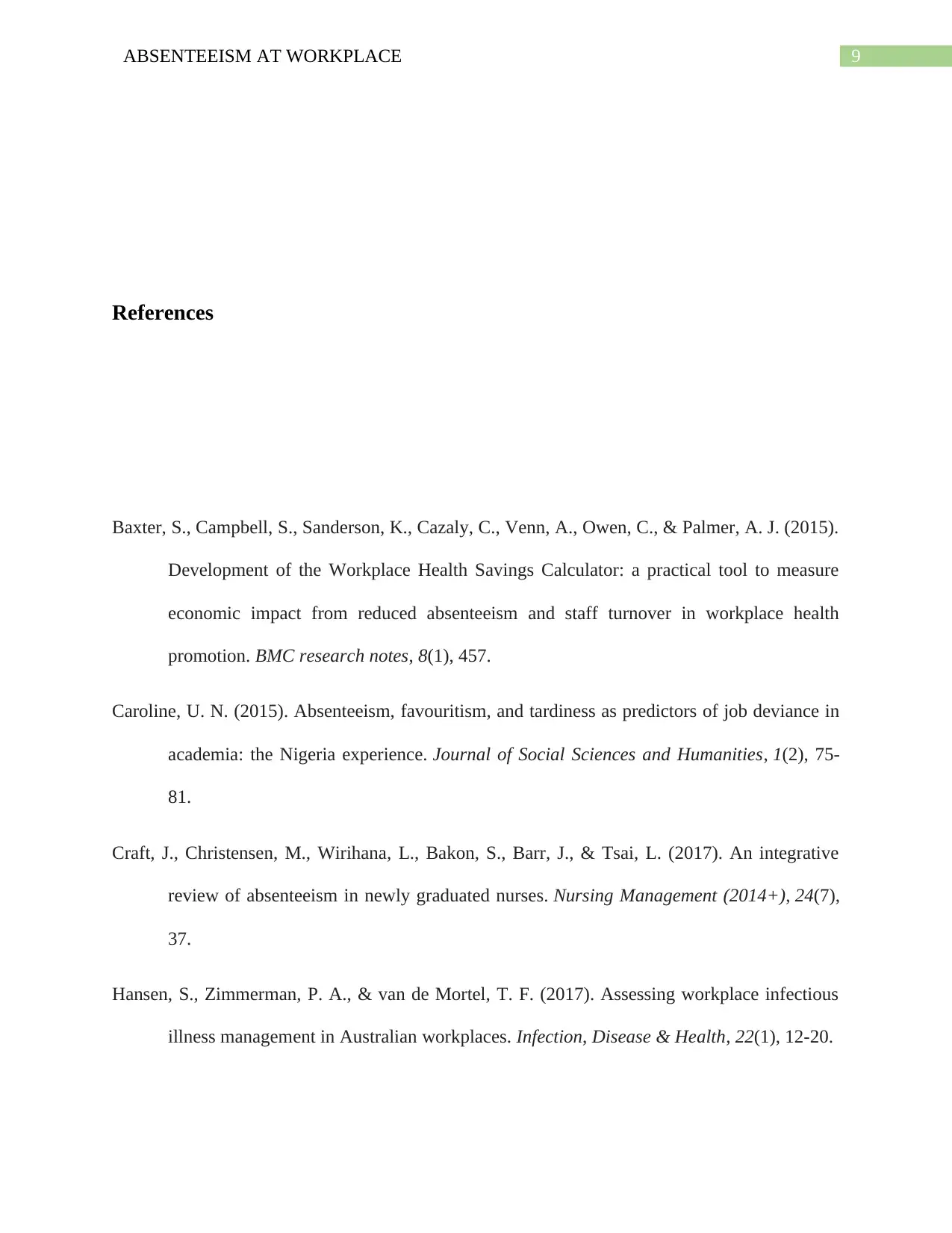
9ABSENTEEISM AT WORKPLACE
References
Baxter, S., Campbell, S., Sanderson, K., Cazaly, C., Venn, A., Owen, C., & Palmer, A. J. (2015).
Development of the Workplace Health Savings Calculator: a practical tool to measure
economic impact from reduced absenteeism and staff turnover in workplace health
promotion. BMC research notes, 8(1), 457.
Caroline, U. N. (2015). Absenteeism, favouritism, and tardiness as predictors of job deviance in
academia: the Nigeria experience. Journal of Social Sciences and Humanities, 1(2), 75-
81.
Craft, J., Christensen, M., Wirihana, L., Bakon, S., Barr, J., & Tsai, L. (2017). An integrative
review of absenteeism in newly graduated nurses. Nursing Management (2014+), 24(7),
37.
Hansen, S., Zimmerman, P. A., & van de Mortel, T. F. (2017). Assessing workplace infectious
illness management in Australian workplaces. Infection, Disease & Health, 22(1), 12-20.
References
Baxter, S., Campbell, S., Sanderson, K., Cazaly, C., Venn, A., Owen, C., & Palmer, A. J. (2015).
Development of the Workplace Health Savings Calculator: a practical tool to measure
economic impact from reduced absenteeism and staff turnover in workplace health
promotion. BMC research notes, 8(1), 457.
Caroline, U. N. (2015). Absenteeism, favouritism, and tardiness as predictors of job deviance in
academia: the Nigeria experience. Journal of Social Sciences and Humanities, 1(2), 75-
81.
Craft, J., Christensen, M., Wirihana, L., Bakon, S., Barr, J., & Tsai, L. (2017). An integrative
review of absenteeism in newly graduated nurses. Nursing Management (2014+), 24(7),
37.
Hansen, S., Zimmerman, P. A., & van de Mortel, T. F. (2017). Assessing workplace infectious
illness management in Australian workplaces. Infection, Disease & Health, 22(1), 12-20.
Paraphrase This Document
Need a fresh take? Get an instant paraphrase of this document with our AI Paraphraser
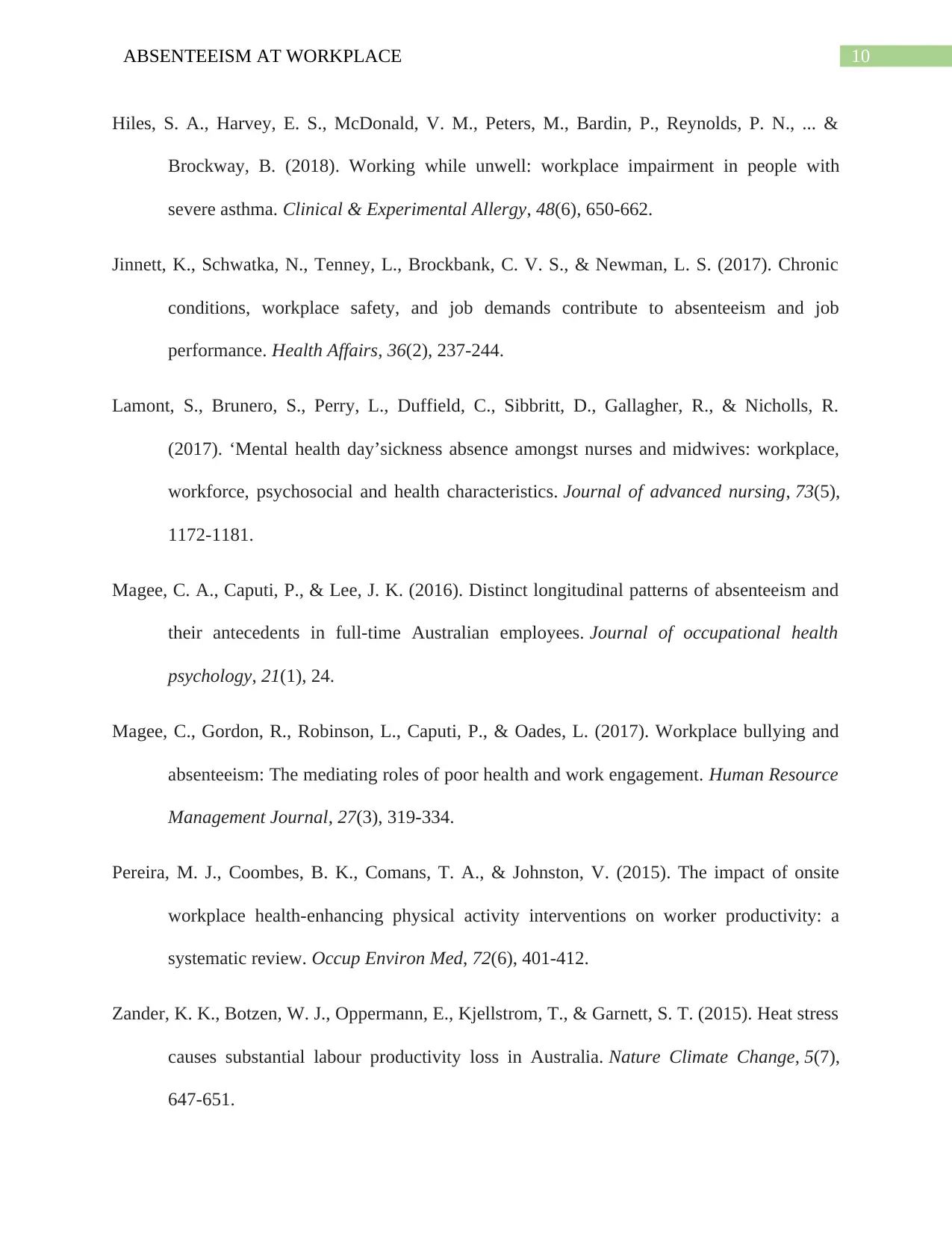
10ABSENTEEISM AT WORKPLACE
Hiles, S. A., Harvey, E. S., McDonald, V. M., Peters, M., Bardin, P., Reynolds, P. N., ... &
Brockway, B. (2018). Working while unwell: workplace impairment in people with
severe asthma. Clinical & Experimental Allergy, 48(6), 650-662.
Jinnett, K., Schwatka, N., Tenney, L., Brockbank, C. V. S., & Newman, L. S. (2017). Chronic
conditions, workplace safety, and job demands contribute to absenteeism and job
performance. Health Affairs, 36(2), 237-244.
Lamont, S., Brunero, S., Perry, L., Duffield, C., Sibbritt, D., Gallagher, R., & Nicholls, R.
(2017). ‘Mental health day’sickness absence amongst nurses and midwives: workplace,
workforce, psychosocial and health characteristics. Journal of advanced nursing, 73(5),
1172-1181.
Magee, C. A., Caputi, P., & Lee, J. K. (2016). Distinct longitudinal patterns of absenteeism and
their antecedents in full-time Australian employees. Journal of occupational health
psychology, 21(1), 24.
Magee, C., Gordon, R., Robinson, L., Caputi, P., & Oades, L. (2017). Workplace bullying and
absenteeism: The mediating roles of poor health and work engagement. Human Resource
Management Journal, 27(3), 319-334.
Pereira, M. J., Coombes, B. K., Comans, T. A., & Johnston, V. (2015). The impact of onsite
workplace health-enhancing physical activity interventions on worker productivity: a
systematic review. Occup Environ Med, 72(6), 401-412.
Zander, K. K., Botzen, W. J., Oppermann, E., Kjellstrom, T., & Garnett, S. T. (2015). Heat stress
causes substantial labour productivity loss in Australia. Nature Climate Change, 5(7),
647-651.
Hiles, S. A., Harvey, E. S., McDonald, V. M., Peters, M., Bardin, P., Reynolds, P. N., ... &
Brockway, B. (2018). Working while unwell: workplace impairment in people with
severe asthma. Clinical & Experimental Allergy, 48(6), 650-662.
Jinnett, K., Schwatka, N., Tenney, L., Brockbank, C. V. S., & Newman, L. S. (2017). Chronic
conditions, workplace safety, and job demands contribute to absenteeism and job
performance. Health Affairs, 36(2), 237-244.
Lamont, S., Brunero, S., Perry, L., Duffield, C., Sibbritt, D., Gallagher, R., & Nicholls, R.
(2017). ‘Mental health day’sickness absence amongst nurses and midwives: workplace,
workforce, psychosocial and health characteristics. Journal of advanced nursing, 73(5),
1172-1181.
Magee, C. A., Caputi, P., & Lee, J. K. (2016). Distinct longitudinal patterns of absenteeism and
their antecedents in full-time Australian employees. Journal of occupational health
psychology, 21(1), 24.
Magee, C., Gordon, R., Robinson, L., Caputi, P., & Oades, L. (2017). Workplace bullying and
absenteeism: The mediating roles of poor health and work engagement. Human Resource
Management Journal, 27(3), 319-334.
Pereira, M. J., Coombes, B. K., Comans, T. A., & Johnston, V. (2015). The impact of onsite
workplace health-enhancing physical activity interventions on worker productivity: a
systematic review. Occup Environ Med, 72(6), 401-412.
Zander, K. K., Botzen, W. J., Oppermann, E., Kjellstrom, T., & Garnett, S. T. (2015). Heat stress
causes substantial labour productivity loss in Australia. Nature Climate Change, 5(7),
647-651.
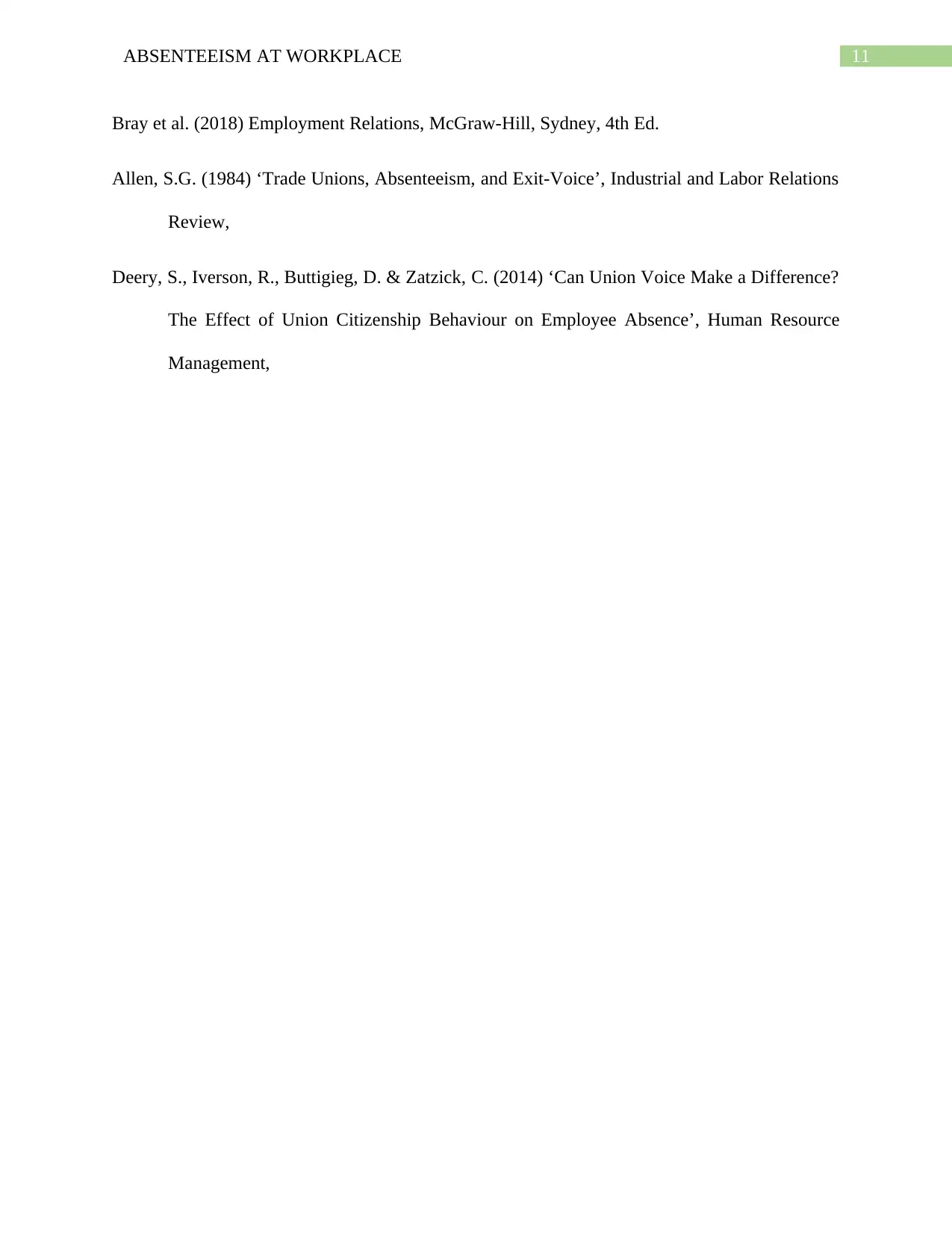
11ABSENTEEISM AT WORKPLACE
Bray et al. (2018) Employment Relations, McGraw-Hill, Sydney, 4th Ed.
Allen, S.G. (1984) ‘Trade Unions, Absenteeism, and Exit-Voice’, Industrial and Labor Relations
Review,
Deery, S., Iverson, R., Buttigieg, D. & Zatzick, C. (2014) ‘Can Union Voice Make a Difference?
The Effect of Union Citizenship Behaviour on Employee Absence’, Human Resource
Management,
Bray et al. (2018) Employment Relations, McGraw-Hill, Sydney, 4th Ed.
Allen, S.G. (1984) ‘Trade Unions, Absenteeism, and Exit-Voice’, Industrial and Labor Relations
Review,
Deery, S., Iverson, R., Buttigieg, D. & Zatzick, C. (2014) ‘Can Union Voice Make a Difference?
The Effect of Union Citizenship Behaviour on Employee Absence’, Human Resource
Management,
⊘ This is a preview!⊘
Do you want full access?
Subscribe today to unlock all pages.

Trusted by 1+ million students worldwide
1 out of 12
Related Documents
Your All-in-One AI-Powered Toolkit for Academic Success.
+13062052269
info@desklib.com
Available 24*7 on WhatsApp / Email
![[object Object]](/_next/static/media/star-bottom.7253800d.svg)
Unlock your academic potential
Copyright © 2020–2025 A2Z Services. All Rights Reserved. Developed and managed by ZUCOL.





